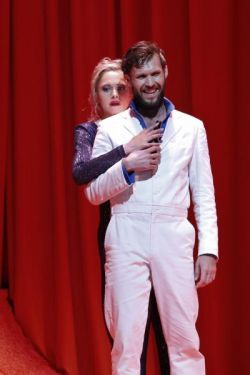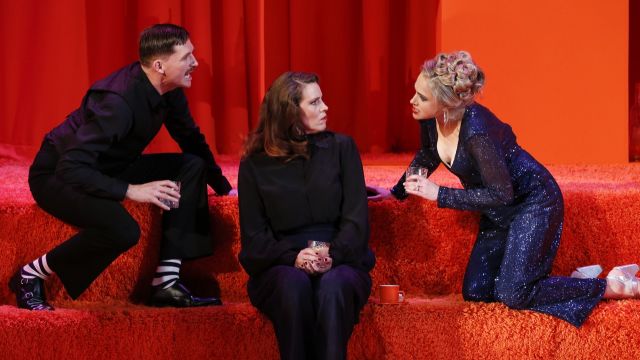Abigail’s Party
Beverly (Pip Edwards) and Laurence (Daniel Frederiksen), an upwardly mobile couple – that is, struggling out of the working class - have invited a few friends around for drinks and nibbles. That is, Beverly has invited them. Laurence, a stressed, harassed real estate agent, could really do without it and them.
But Beverly, wanting to show off her redecorated house and her gorgeous figure in her spangled jumpsuit, figures a party will be ‘fun’. That’s what parties are for. So, if you have one, it’s fun. It should be fun. Especially if a lot of alcohol is consumed. She invites new neighbours Angela (Zoe Boesen), a nurse, and her husband Tony (Benjamin Rigby), a spunky ex-footballer, now ‘in computers’. The Abigail’s party of the title is the sixteenth birthday party across the street. We never see Abigail and we only hear the party, which we suspect might be more fun than Beverly’s. But Beverly does invite Abigail’s mother, divorcee Susan (Katherine Tonkin), a decidedly middle-class contrast to the others. To describe this mix as awkward would be putting it mildly – and for a time it looks as if Beverly is the only one having fun – but she is, in fact, so tense, it’s painful to watch her chatter loudly but aimlessly, bully her guests, top up unwanted drinks, abuse her husband and blatantly deploy her behind in flirting with the stolid Tony.
 This 1977 play by Mike Leigh (the play that really made his name) is, I think, a ‘naturalistic’ piece about one awful evening with five suburbanites – naturalistic in the Mike Leigh mode of naturalism. That is, heightened just that bit to point up the pathos, inanities, and sad aspirations of his characters. The comedy makes it bearable. This relatively early play is somewhat more benign than the darker works that followed. In a long program note about the play, which he calls ‘a lament’, Mr Leigh stresses that his intention is ‘tragi-comedy’ and that it is ‘obviously sympathetic to all the characters… [whom] the audience experience… in a real, three-dimensional way.’ Naturally, no production is duty bound to honour the playwright’s intention (and, anyway, never trust the teller, trust the tale), but here ‘real’ and ‘three-dimensional’ do not apply.
This 1977 play by Mike Leigh (the play that really made his name) is, I think, a ‘naturalistic’ piece about one awful evening with five suburbanites – naturalistic in the Mike Leigh mode of naturalism. That is, heightened just that bit to point up the pathos, inanities, and sad aspirations of his characters. The comedy makes it bearable. This relatively early play is somewhat more benign than the darker works that followed. In a long program note about the play, which he calls ‘a lament’, Mr Leigh stresses that his intention is ‘tragi-comedy’ and that it is ‘obviously sympathetic to all the characters… [whom] the audience experience… in a real, three-dimensional way.’ Naturally, no production is duty bound to honour the playwright’s intention (and, anyway, never trust the teller, trust the tale), but here ‘real’ and ‘three-dimensional’ do not apply.
Director Stephen Nicolazzo, set designer Anna Cordingley and costume designer Eugyeene Teh take ‘heightened reality’ and heighten it further – much further. Of course, we have come to expect a stylised take on any text from Mr Nicolazzo and he has given us some wonderfully inventive, entertaining and pointed high camp evenings – where casting and tone offer a critique of the material. In this case, I am not so sure it works - despite his claim in an MTC podcast to love this play. Here, he puts his stamp on things with excess – in the performances and the design – almost as if – but this can’t be so, can it? – he has set out to take the mickey out of the play and its characters. As if ‘ordinary people’ (‘”us” not “them”, as Mr Leigh writes) are not that interesting.
Ms Cordingley’s central set is an assault in ghastly orange – a shallow playing space that ensures the actors are frequently jammed together, with shagpile carpeted steps down to what was once called a ‘conversation pit’ – no other furniture – and all else is colour coordinated. Stage right, an alcove with a huge mirror in which, pre-party, Beverly postures and poses. Stage left, another alcove containing a toilet, and underneath that a space for Laurence’s Mini-Minor. The point of these additions is somewhat obscure, but the orange, surely, is there to mock Beverly’s taste – or the prevailing taste of 1977. As to the costumes, Ms Edwards fortunately looks as good as her character hopes she does in her jumpsuit, but when Ms Boesen enters with a large cantilevered hair-do that resembles a basket, we start to suspect the intention is to make a fool of the character – a character who is a nurse and who must function as a nurse within the play?
 It must be said that Ms Edwards’ Beverly is brilliant sustained performance per se of manic, grating energy, interrupted only by moments when the character is alone or unobserved and we glimpse the lonely, empty, scared girl behind the aggressive front. Nevertheless, it’s a performance that goes beyond plausible – as does that of Ms Boesen. Her Angela’s almost stream of consciousness dialogue here suggests stupidity rather than the nervousness of a shy woman (wrongly) intimidated by Beverly and her flash house. Mr Rigby, as Tony, really doesn’t have a lot to do – he gets laughs by being monosyllabic; the character is spunky but oh-so-dull. (He might be Mr Leigh’s 1977 comment on ‘computers’.) Ms Tonkin’s Susan just escapes being a cartoon by simply being polite and quiet, and with the clear motive of escape. Mr Frederiksen exhibits his range and always strong presence: amidst the chaos and overall over-acting, his Laurence has some dignity and purpose. We feel for this man with his frustrated but cliché aspirations and the wife he should never have married, but whom he’ll never understand.
It must be said that Ms Edwards’ Beverly is brilliant sustained performance per se of manic, grating energy, interrupted only by moments when the character is alone or unobserved and we glimpse the lonely, empty, scared girl behind the aggressive front. Nevertheless, it’s a performance that goes beyond plausible – as does that of Ms Boesen. Her Angela’s almost stream of consciousness dialogue here suggests stupidity rather than the nervousness of a shy woman (wrongly) intimidated by Beverly and her flash house. Mr Rigby, as Tony, really doesn’t have a lot to do – he gets laughs by being monosyllabic; the character is spunky but oh-so-dull. (He might be Mr Leigh’s 1977 comment on ‘computers’.) Ms Tonkin’s Susan just escapes being a cartoon by simply being polite and quiet, and with the clear motive of escape. Mr Frederiksen exhibits his range and always strong presence: amidst the chaos and overall over-acting, his Laurence has some dignity and purpose. We feel for this man with his frustrated but cliché aspirations and the wife he should never have married, but whom he’ll never understand.
Leaving aside the question of question of why revive this play at all, the salient question is why do it this way? You can’t help wondering about that when possibly the biggest laugh of the evening from the (I suspect) bemused audience comes when somebody is sick and their vomit runs down a glass plane. Mr Leigh’s texts are not robust; they depend on nuance and a subtext of misplaced beliefs and inchoate yearnings. To burden this one with caricature, madness and crassness rather obviates the value of doing it at all.
Michael Brindley
Subscribe to our E-Newsletter, buy our latest print edition or find a Performing Arts book at Book Nook.

